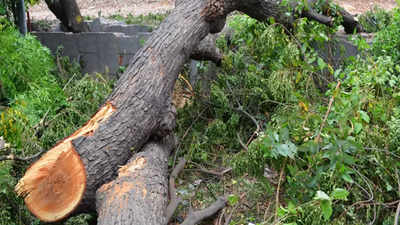- News
- City News
- ahmedabad News
- Axe effect: Ahmedabad district second biggest loser
Trending
This story is from January 19, 2022
Axe effect: Ahmedabad district second biggest loser
In the state, Ahmedabad district was the second biggest loser in terms of the green cover. The latest report of Forest Survey of India reveals that urban areas as well as tribal zones in Gujarat have registered a decline in the green cover.

Representative image
AHMEDABAD: In the state, Ahmedabad district was the second biggest loser in terms of the green cover. The latest report of Forest Survey of India reveals that urban areas as well as tribal zones in Gujarat have registered a decline in the green cover.

Narmada district registered the steepest fall of nearly 21 sq km in the green cover in 2021 as compared to the 2019 figures.Officials in the forest department said that one of the factors that affected tribal districts was the state government’s decision in 2015 to remove 87 different tree species. Ordinarily, the forest department is consulted before such a tree-cutting drive. In the end, tribal districts lost a large number of trees.
The officials said that in districts such as Ahmedabad there has been rampant erosion of the green cover owing to urbanization not just within city areas but also in the adjacent rural swathes. The officials said that apart from urbanization, the threat to trees comes from road-expansion projects. These projects include Ahmedabad-Rajkot, Ahmedabad-Bhavnagar, and Ahmedabad-Udaipur stretches on which trees have been cut on a large scale.
The officials said that the state government’s recent count had showed an increase in the number of trees because the count had considered trees of even 10cm girth. But, the officials said, Forest Survey of India data is accurate as it is based on estimates derived from the study of satellite images.
The officials said that of the 14,925.9 sq km area, 2,828 sq km has shrubs including gando baval (prosopis juliflora). The officials said that the increase in the overall forest cover of the state was 68.5 sq km compared to the previous estimate. But in the case of Kutch, it was 94.2 sq km mainly because of the gando baval proliferation. Hence it appears that over the last two censuses, the state is making up for the loss of the green cover by taking the gando baval spread into account.
However, according to officials, there is no change in the dense forest cover, which is defined as a canopy density of over 70%. There was a decline of 60 sq km in moderately dense forests, where the canopy cover is between 40% and 70%. Many patches of moderately dense forests have turned into open forests, again because of gando baval.

Narmada district registered the steepest fall of nearly 21 sq km in the green cover in 2021 as compared to the 2019 figures.Officials in the forest department said that one of the factors that affected tribal districts was the state government’s decision in 2015 to remove 87 different tree species. Ordinarily, the forest department is consulted before such a tree-cutting drive. In the end, tribal districts lost a large number of trees.
The officials said that in districts such as Ahmedabad there has been rampant erosion of the green cover owing to urbanization not just within city areas but also in the adjacent rural swathes. The officials said that apart from urbanization, the threat to trees comes from road-expansion projects. These projects include Ahmedabad-Rajkot, Ahmedabad-Bhavnagar, and Ahmedabad-Udaipur stretches on which trees have been cut on a large scale.
Moreover, green cover is thinning in AUDA (Ahmedabad Urban Development Authority) areas which are the sites of rapid development.
The officials said that the state government’s recent count had showed an increase in the number of trees because the count had considered trees of even 10cm girth. But, the officials said, Forest Survey of India data is accurate as it is based on estimates derived from the study of satellite images.
The officials said that of the 14,925.9 sq km area, 2,828 sq km has shrubs including gando baval (prosopis juliflora). The officials said that the increase in the overall forest cover of the state was 68.5 sq km compared to the previous estimate. But in the case of Kutch, it was 94.2 sq km mainly because of the gando baval proliferation. Hence it appears that over the last two censuses, the state is making up for the loss of the green cover by taking the gando baval spread into account.
However, according to officials, there is no change in the dense forest cover, which is defined as a canopy density of over 70%. There was a decline of 60 sq km in moderately dense forests, where the canopy cover is between 40% and 70%. Many patches of moderately dense forests have turned into open forests, again because of gando baval.
End of Article
FOLLOW US ON SOCIAL MEDIA










